The shortlisted films for this year’s visual effects category at the Academy Awards reveal how the sector has moved beyond the sci-fi and fantasy realm into comedies and dramas. John Hazelton eyes the field of contenders.
Increasingly international and fiercely competitive, the visual-effects sector is now a vitally important component of the wider global film industry. And that is not just because of the massive commercial success of effects-heavy fantasy adventures and comic book-based action films. These days, digital effects created on any one of four continents can play a part in comedies, dramas and animated family films as well.
The 10-film shortlist for this year’s visual effects Academy Award — the list from which five nominees will soon be chosen — covers a range of genres, each of which has produced at least one visual effects Oscar winner during the past decade.
From the realms of sci-fi — genre of recent Oscar winners Inception and Avatar — come the alien planet epic Prometheus, the historical/futuristic Cloud Atlas and the Mars-set John Carter.
The fantasy genre — producer of the multiple Oscar-winning The Lord Of The Rings films — this year provides dark fairy tale Snow White & The Huntsman and The Lord Of The Rings prequel The Hobbit: An Unexpected Journey.
The comic-book world — whose only recent winner has been Spider-Man 2 — has the rebooted The Amazing Spider-Man, Marvel’s The Avengers and Batman trilogy finale The Dark Knight Rises in this year’s running.
And then — following recent winners Hugo, The Curious Case Of Benjamin Button and Pirates Of The Caribbean: Dead Man’s Chest — there are the less genre-specific entries: dramatic adventure Life Of Pi, with its CG-enhanced animals and seascapes, and action thriller Skyfall, which could become the first James Bond film since Moonraker to be nominated in the category.
The Oscar hopefuls illustrate some of the creative challenges visual effects experts face in a world of demanding directors, sophisticated audiences and massively expanded computing power.
On The Avengers, a film that includes 2,200 effects shots, one of the main tasks was to create a new version of the Hulk that incorporated more emotion than previous screen versions of the green super-hero.
“The mandate was to create the most successful Hulk we could, given the technology of 2011,” says executive producer and Marvel executive vice-president of visual effects Victoria Alonso. “Mark Ruffalo [who played the character in human form] was very helpful in allowing us to capture the facial expressions that we later on tried to translate to the digital Hulk.”
In The Amazing Spider-Man, a big effects effort went into the creation of half-reptile, half-man villain, the Lizard, the most complex character ever built by the production’s primary visual effects company Sony Pictures Imageworks.
While the film’s design team made a maquette of the creature, “it was our job to breathe life into it,” says David Smith, the production’s digital effects supervisor. “Our challenge throughout the film was to put depth and dimensionality into characters and scenes.”
The effects artists on Prometheus spent much of their time creating the planet on which the action takes place, blending footage of real locations with CG enhancements.
Director Ridley Scott “had a very specific view of what he wanted for the landscape,” says the film’s visual effects supervisor Richard Stammers. “We drew on a couple of real locations that he really liked and had to blend those together in an unearthly way.
“That’s something that works fairly well throughout Prometheus,” Stammers adds. “We had a very good practical starting point to a lot of the sequences.”
On Cloud Atlas the effects team contributed to several of the multiple story-lines, most notably creating much of the sci-fi environment of the film’s Neo Seoul setting but also helping to morph the recurring characters from one narrative to another.
The challenge, says senior visual effects supervisor Dan Glass, was to “design and deliver work that was appropriate for each story and yet fitted into a holistic whole”.
The Dark Knight Rises had a relatively low count of effects shots “but the amount of effort that went into creating those less than 500 shots was considerably greater than the amount that went into creating the 650 shots back on Batman Begins [the first film in director Christopher Nolan’s Batman trilogy],” says visual effects supervisor Paul Franklin, an Oscar winner for his work on Nolan’s Inception.
The extra effort resulted from Nolan’s decision to shoot nearly half of the film using Imax large-format cameras — which create 20 times the number of pixels in each image — and to set most of the film’s action in daylight.
“With this much higher level of clarity, you suddenly begin to realise that all of the crude approximations that we often tend to use in visual effects just won’t work any more,” Franklin reports.
For effects-heavy daylight sequences such as the film’s football stadium invasion “we were having to develop new tools to produce this added level of realism,” Franklin says.
For some of its 2,200 effects shots, The Hobbit: An Unexpected Journey used the latest versions of techniques originally developed for The Lord Of The Rings trilogy at director Peter Jackson’s Weta Digital effects operation in New Zealand. But the production also had to tackle new challenges, says senior visual effects supervisor and Weta Digital director Joe Letteri, who has won Oscars for the second and third Rings films, as well as for Avatar and King Kong.
Shooting in 3D, for example, ruled out the traditional forced perspective technique used to make actors appear hobbit-sized in the Rings films. “So we had to come up with a dynamic forced perspective system,” says Letteri, “that was basically a two-camera system using two sets built to two different scales.
The fact The Hobbit was shot at 48 rather than 24 frames per second, on the other hand, helped the effects team create more accurate animation. “There’s less motion blur,” Letteri explains, “and we’re able to use that mostly in animation because now you have more frames to deal with, so quick motion can be handled more accurately.”
The Oscar contenders also illustrate the different approaches that productions are taking to the management of their visual effects workloads. Most of this year’s big effects features divided their work among multiple effects houses in several locations around the world, partly for creative reasons but also to take advantage of lower labour costs and the incentives offered for post-production work in some territories.
“We always try to get the best team possible and then we try to figure out the costs,” says Marvel’s Alonso, whose The Avengers placed work at 13 other vendors in addition to the main facilities, Industrial Light & Magic and Weta Digital. “I don’t believe in putting all the eggs in one basket because you don’t know what’s going to happen to any given company at any given time.”
A couple of this year’s contenders, however, used just one or two facilities, with The Hobbit placing all its work at Weta and The Dark Knight Rises using just Double Negative in London and New Deal in Los Angeles for miniatures.
The Dark Knight Rises director Nolan “felt it was really important to reduce the number of people who were involved in the decision-making process for visual effects”, says Franklin, one of Double Negative’s founders. “He wanted to have the guys who were going to do the work and assemble the shots on set with him throughout the shoot and liaising with him through pre-production.”
The Global Scene
New international effects hubs are emerging as serious players.
With leading companies based in the US, the UK and New Zealand, and other significant operations in Canada, Australia, France and Germany, visual effects is already an international business. But it could soon become even more global in scope as new players from new territories become more competitive.
For one thing, the quality of work produced in some emerging markets is improving, according to industry practitioners.
“Vancouver has been surging and has an enormous concentration of talent,” says Dan Glass, chief creative officer at Method Studios, which has facilities in Los Angeles, Vancouver, New York, Chicago, Atlanta, London and Sydney. “It has yet to produce the complexity of some of the work that London can output, but I don’t think it’s far off. And Australia’s probably getting close.”
Next to emerge could be some of the territories to which established companies have been ‘off-shoring’ — as opposed to out-sourcing — some of their work: territories such as India, China, Malaysia and Singapore.
Though off-shoring to India and South-East Asia has in part been spurred by lower labour costs in the region, “there’s also incredible talent there,” says Richard Stammers of the Moving Picture Company, the London-based effects operation that has facilities in Vancouver, Los Angeles, New York and Bangalore.
“There is so much animation work being done in that part of the world and there are really talented people available,” adds Stammers.
There is also investment capital, as illustrated by the recent acquisition of US effects pioneer Digital Domain by Reliance MediaWorks — part of India’s Reliance conglomerate — and Galloping Horse America, part of a China-based media operation.
Snapshot: The Dark Knight Rises - Controlled destruction
Among the eye-popping scenes in this year’s effects-heavy blockbusters is the sequence in The Dark Knight Rises that sees Batman’s nemesis Bane taking over a Gotham City football stadium [pictured]. Bane sets off a series of explosions that causes the field to collapse inches behind the heels of a player running into the end-zone.
Visual effects supervisor Paul Franklin explains the scene called for a tricky combination of impressive destruction and controlled precision: “Creating all of those layers of dirt and concrete and rubble required a very, very complicated physics solution. But we still had to be able to maintain a very high level of creative control over the process so the field collapses in a precisely choreographed manner.”
“It’s an audacious moment but it’s being presented with the clarity of photo-realism.”




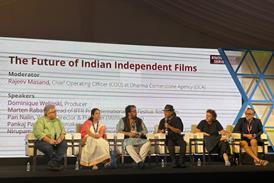
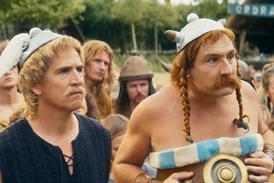

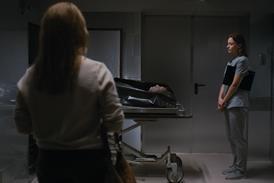


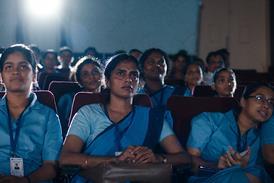


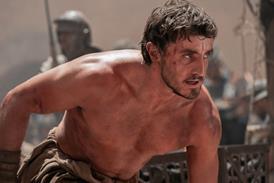








No comments yet